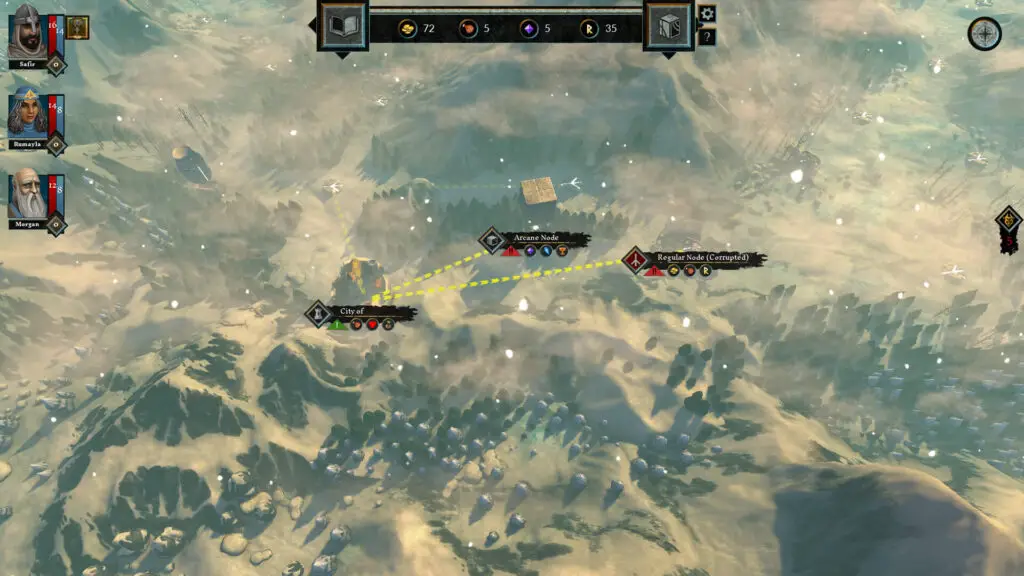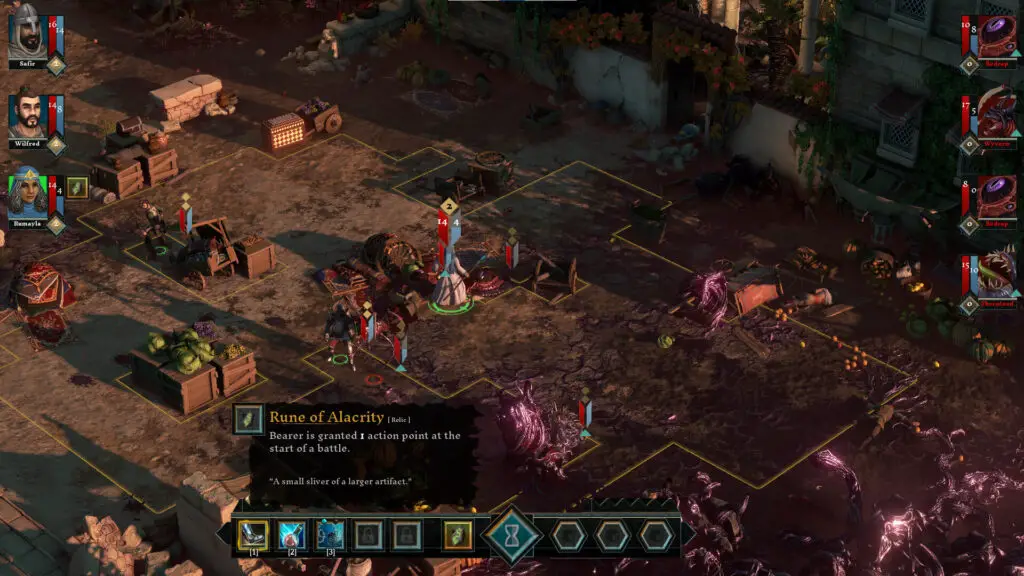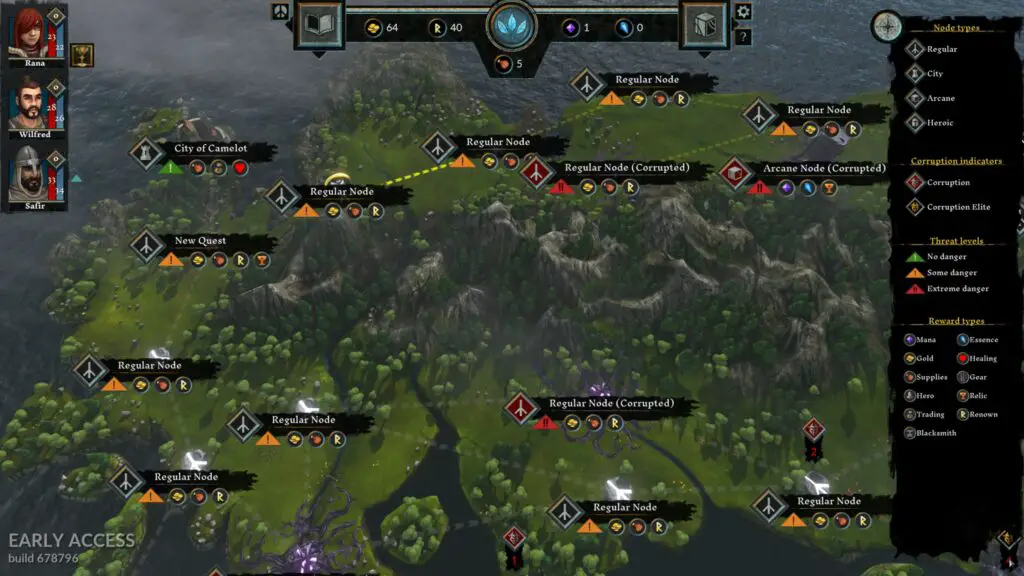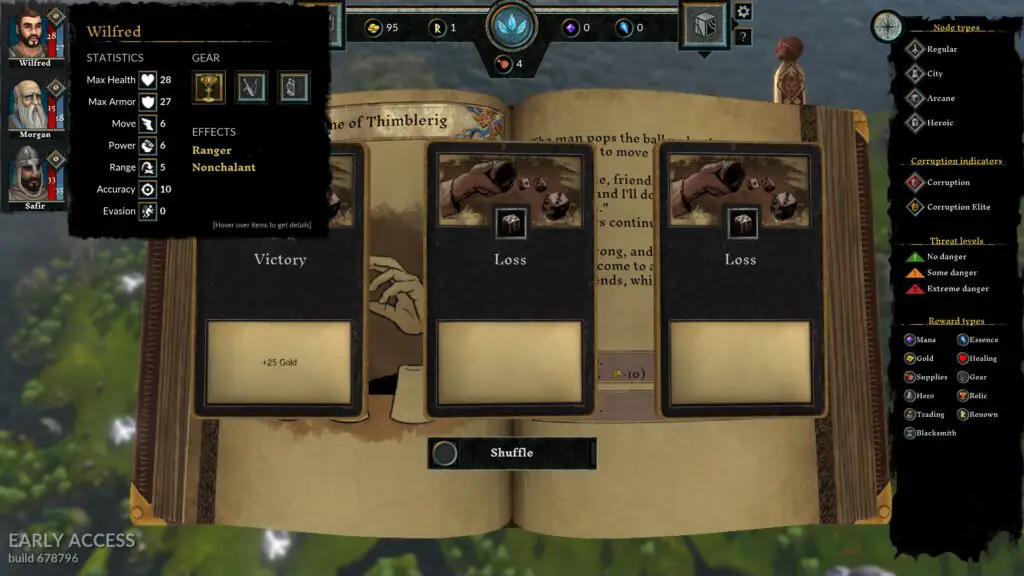Let’s take a journey into a classic-styled turn-based tactical game with roguelite elements by Room-C Games and Croteam. Pick your heroes in a team of three and travel across Avalon. Fight against bandits and horrors from another dimension to protect your reality.

OVERVIEW
The story takes place in post-Arthurian Avalon, which is devastated by invading otherworldly spawns from a different dimension. During the course of the game, you have to travel across different lands, going through various nodes. In the nodes, you are faced with choices, all of which have consequences. Each node you visit will open up your journal. Within the journal you are faced with people and situations during which you make your choices.
You are faced with the consequences of your actions, or maybe even learning about the enemy you will be facing. Each time you begin a new run, it will be set in a parallel dimension in which history has gone a little differently. Other kings which succeeded Arthur, with some minor differences in events and nodes, but little to no story changes. However, there are some twists based on the choices you make in the main nodes.

The combat is turn-based with a square grid. The tactical map’s environment has a lot of elements to use for your advantage as cover. The cover is split into half or full height, all of which is destructible. Every encounter starts with you moving first, unless the event states otherwise. An example is getting ambushed by bandits. In some cases the enemy is unaware of your presence, giving you an opportunity to reposition yourself.
You have action points that are used to move and take action like attack, use skills, or dash. Most skills have cooldowns, and in some cases limited usage per combat scenario. You are also able to use spells from Merlin‘s list (or some of the other great mages like Morgana and Oberon) which require mana. Mana is a rare resource that is obtained through events in nodes, and it can be used instead of action points.
CHARACTER PROGRESSION AND EVENTS
To level up the members of your warband, you’ll need to get “renown”. It’s used to unlock upgrades and improves some of your statistics. Along with that, you get a random skill from a pool of three (while later in the game you get the choice of picking one of the random upgrades for one of your skills). While equipment on the other hand is upgraded differently, you need to improve it in one of the major towns. However, in some of the node events you can pay for the services of a blacksmith. Along with buying relics that are also obtainable in certain events. The relics grant you passive and in some cases active bonuses as well.

In every town you can buy provisions, which are necessary for preventing maladies which can affect your troops. They can also start some events, heal the members of your group and take a well-deserved rest. There are some side quests that begin upon reaching certain nodes. They’re visible on the region’s map but they still work the same as other event nodes with two or three variations which have multiple choices and consequences.
THE JOURNAL AND GENERAL UI
In The Hand of Merlin, information about some of your characters is accessible anytime on the region’s map as well as the tactical map which gives you hints about the current condition of your party. You are also shown the relics they are equipped with along with what buffs/debuffs they have. Navigation between menus is easy and flows naturally. Like the journal that you need to keep an eye on due to it shows your warbands statistics and skills. Which keeps you mindful of leveling them up. There’s also the guardian core in which you choose and unlock your mage’s spells.
All the aspects of the game are easily accessible and understandable thanks to the help menu that covers every aspect of the game. Hints will pop up to help you on your first playthrough. You also have a vertical banner on your left which indicates what kind of node you are faced with depending on the icon shown. Corruption indicators, threat levels, and reward types are also shown on each node. You can also turn each of the icons on or off, you also have the option to just leave the icon of the closest node to you on.
During a fight you can look at the same warband statistics chart you have access to in the region’s map. But in this case you also see the statistics of the enemy are you facing. Again, with a list of all the buffs, debuffs, and skills available for you and your enemies. The square grid shows you the movement capabilities of your party including the range of their skills and their area of effect, along with the probability of a successful attack shown in percentages.

GOOD BUT STILL ROUGH
The game has a decent amount of replayability, the initial roster of characters, one for each “class” which are: warrior, ranger and mystic. All of each can be tailored in order to give a good initial variety but they are still only three and even if there are different “characters” with different starting passive and active skills for all of them you’ll probably find soon your wombo-combo and stick with it, the addition of different skills and effects would probably solve this. Same for the skill’s when leveling up, which has a limited pool of choice and if you like the roguelite element of not knowing which set of skills you’ll be able to choose from you’ll appreciate it, otherwise, it will be more an unwanted difficulty spike.
The events add another layer of randomness to the game but you’ll find them repetitive soon enough just on the second run, again, this could be solved by adding variety in the choice and consequences system. Speaking of replayability, there are only four regions before the final battle and the biomes are quite repetitive with no influence on the overall difficulty saves for enemy number and types, even the aforementioned enemies suffer from a lack of variety, especially humans, who stick primarily on the same composition of your warband with warriors, rangers, and mystics all with the same look.
Some hybrid enemy types like “infected” humans and a sort of corruption system could be a great asset for gameplay variety. Also giving the player different objectives other than the usual intrinsic “exterminate” during encounters like protecting some key target, destroying a key target or surviving a number of enemy waves.

IN CONCLUSION
The Hand of Merlin is a game for people who like to take risky and permanent decisions, where the fights must be approached with tactical mind, where your warbands skills must be the most synergic you can to overcome the latest stages of the game, but it suffers from a lack of variety from what regard classes, enemies, skills and choice to be made through the journal.
Region and biomes are the same to one another save for the looking, there’s no interaction with the environment except for the usual three of four things to use like covers or destroy. It is clear that the game take a lot of inspiration from the classics of the genre trying to add a twist with the rogue-lite element but for now, it is really unripe, there’s a lot of room for improvement and hopefully, the developers will add variety and more endgame content in the future. Fingers crossed.
SUMMARY
The Hand of Merlin is a classic turn-based tactical game, with RPG character progression, non-linear campaign development, and some roguelite element. The variation though tends to be on the lackluster side after a couple of runs and you may find it repetitive quite soon, but the developers seem really passionate and hopefully they will add variety and improvements.







